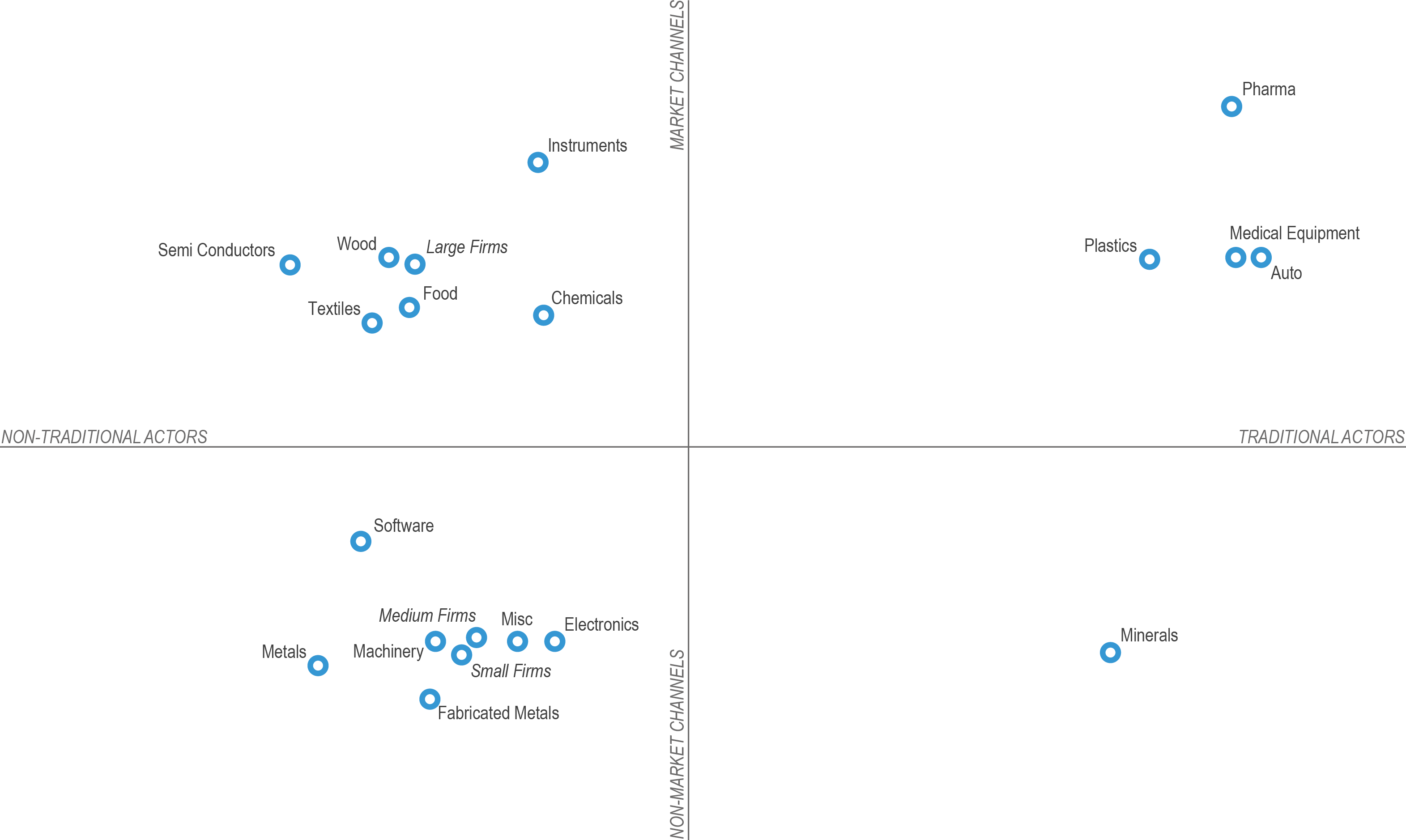Cities interested in bolstering their economies through innovation should look beyond the typical formalized processes.
Instead, a new paper from the Brookings Anne T. and Robert M. Bass Initiative on Innovation and Placemaking pushes economic development leaders to recognize that different types of firms innovate through distinct actors and both market and non-market channels. As a result, regions require industry-tailored innovation-support strategies.
In “How Firms Learn: Industry specific strategies for urban economies,” Brookings Senior Policy Analyst and Associate Fellow Scott Andes examines how manufacturing and software services firms develop new products, processes, and ideas. He illustrates three archetypal innovation models, which correspond to three industry types:
- Classic Industries, such as pharmaceuticals, work primarily with universities and other traditional innovation actors and use market channels, including contracts and licensing agreements, as sources of invention.
- Unconventional Industries, exemplified by small-and medium-sized manufacturers, primarily source innovation from clients and suppliers and pursue informal innovation channels, such as joint research agreements and supplier contracts.
- Mixed Industries predominantly rely on non-traditional actors but formal market channels to acquire innovation. Example industries include semiconductors, chemicals, and textiles.
“In order to build strong regional economies, urban economic development leaders should stop carbon copying other cities’ approaches and instead align local economic strategies with the particular ways their dominant industries innovate,” Andes said.
Specifically, public, private, and institutional stakeholders should develop strategies that:
- Recognize that all industries can be innovative, not just software and medical technology startups, and identify the particular innovation pathways utilized by local firms.
- Eliminate institution-wide technology transfer practices at research universities that focus on licensing and allow specific departments and centers to cater to different industries.
- Establish partnerships with non-research colleges and universities to support firms seeking short-term process innovation.
- Modify the traditional accelerator model to respond to the innovation needs of startups in nontraditional growth sectors.
- Link designers, engineers, and software developers in urban centers to manufacturing supply chains in the surrounding regions.
- Advance appropriate place-based strategies to increase the density of innovative firms and support organizations.
Such industry-contextualized approaches will allow for urban economic development resources to be used to their best advantage and firms and other innovation actors to maximize learning and economic power.
 Sources of innovation and channels by which acquired, by industry. Source: Author’s analysis of Arora, Cohen, and Walsh (2014) and Graham (2009). Click image to enlarge.
Sources of innovation and channels by which acquired, by industry. Source: Author’s analysis of Arora, Cohen, and Walsh (2014) and Graham (2009). Click image to enlarge.
Related Stories
Urban Planning | Oct 30, 2024
Bridging the gap: How early architect involvement can revolutionize a city’s capital improvement plans
Capital Improvement Plans (CIPs) typically span three to five years and outline future city projects and their costs. While they set the stage, the design and construction of these projects often extend beyond the CIP window, leading to a disconnect between the initial budget and evolving project scope. This can result in financial shortfalls, forcing cities to cut back on critical project features.
Designers | Sep 20, 2024
The growing moral responsibility of designing for shade
Elliot Glassman, AIA, NCARB, LEED AP BD+C, CPHD, Building Performance Leader, CannonDesign, makes the argument for architects to consider better shade solutions through these four strategies.
Multifamily Housing | Aug 21, 2024
Nation's leading multifamily developer expands into infrastructure
Greystar's strategy for infrastructure is driven by the shifting landscape of today's cities—primarily in the increased digitization, urbanization, and transitions to clean energy.
Urban Planning | Aug 15, 2024
New York City begins first large-scale porous pavement installation
New York City is installing its first large-scale porous pavement installation along seven miles of roadway in Brooklyn. The project will keep 35 million gallons of stormwater out of the combined sewer system each year, according to a news release.
Urban Planning | Aug 15, 2024
The magic of L.A.’s Melrose Mile
Great streets are generally not initially curated or willed into being. Rather, they emerge organically from unintentional synergies of commercial, business, cultural and economic drivers. L.A.’s Melrose Avenue is a prime example.
MFPRO+ News | Jul 22, 2024
6 multifamily WAFX 2024 Prize winners
Over 30 projects tackling global challenges such as climate change, public health, and social inequality have been named winners of the World Architecture Festival’s WAFX Awards.
Urban Planning | Jun 10, 2024
N.Y. governor halts Manhattan traffic congestion pricing plan
New York Gov. Kathy Hochul says she is indefinitely delaying the implementation of congestion pricing in Manhattan just weeks before the plan was to take effect. The controversial plan would have had drivers pay $15 to enter Manhattan south of 60th street.
Urban Planning | May 28, 2024
‘Flowing’ design emphasizes interaction at Bellevue, Wash., development
The three-tower 1,030,000-sf office and retail development designed by Graphite Design Group in collaboration with Compton Design Office for Vulcan Real Estate is attracting some of the world’s largest names in tech and hospitality.
Mixed-Use | May 22, 2024
Multifamily properties above ground-floor grocers continue to see positive rental premiums
Optimizing land usage is becoming an even bigger priority for developers. In some city centers, many large grocery stores sprawl across valuable land.
Sustainable Development | May 10, 2024
Nature as the city: Why it’s time for a new framework to guide development
NBBJ leaders Jonathan Ward and Margaret Montgomery explore five inspirational ideas they are actively integrating into projects to ensure more healthy, natural cities.

















